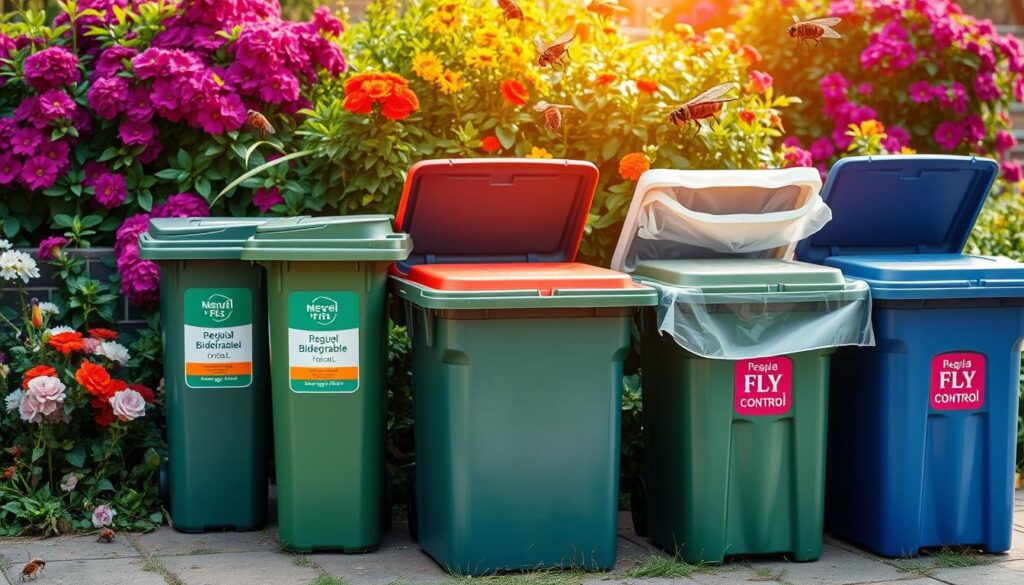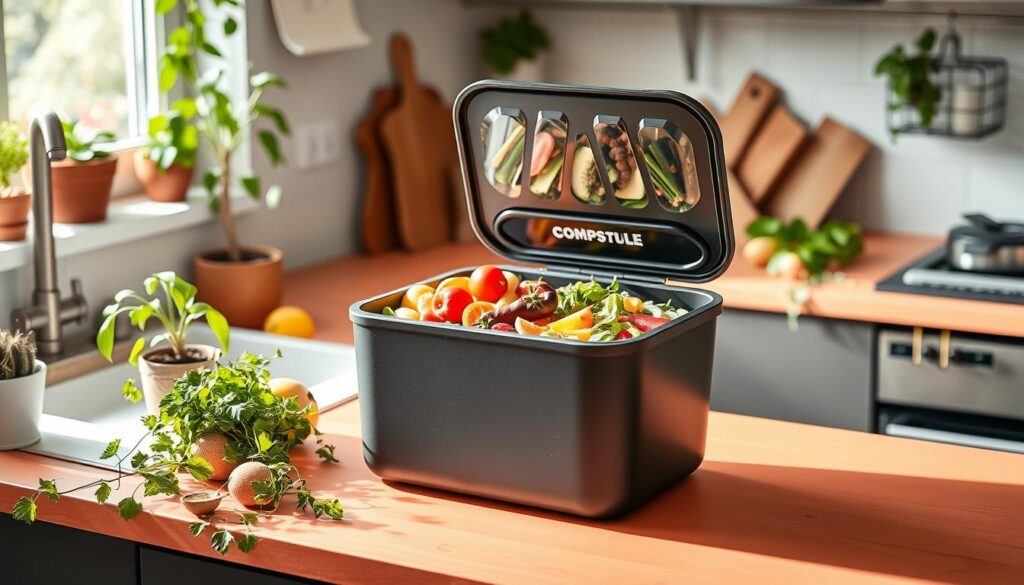As the seasons change and temperatures rise, flies around your wheelie bin can be a big problem. You might wonder if there’s a better way to keep them away. There are many bin liner options, from plastic to eco-friendly biodegradable ones.
But did you know the type of bin liner you use can help fight flies? Get ready to learn how to make your wheelie bin a fly-free zone.
Key Takeaways
- Bin liner gauge ratings range from 40 to 250, with higher numbers indicating increased strength and durability.
- The company offers free delivery on British/Euro made bin liners throughout mainland UK.
- Biodegradable bin liner options are expanding to help combat climate change.
- Bin liners come in various types like biobags, biodegradable sacks, caddy liners, and corn starch liners.
- Bin liners are used in a variety of settings to control odours and maintain cleanliness.
Understanding the Difference Between Biodegradable and Regular Bin Liners
Choosing the right bin liners is important. Biodegradable bin liners, also known as compostable bin liners or biobags, are made from vegetable starch-based materials without plastic. They can break down in 45 days in compost, making them eco-friendly.
Regular bin liners, or plastic bin liners or refuse sacks, are made from plastic. They last longer but don’t break down easily. This can harm our environment.
What are Biodegradable Bin Liners?
Biodegradable bin liners break down naturally. They are made from 100% plant-based materials, like vegetable starch. They are certified to decompose in 45 days in compost. This makes them better for the planet than plastic liners.
Composition and Materials Used in Regular Bin Liners
Regular bin liners are mostly made from plastic. It takes 15 to 1,000 years for plastic to break down. This can pollute our land and seas with microplastics.
| Biodegradable Bin Liners | Regular Bin Liners |
|---|---|
| Made from 100% plant-based materials, such as vegetable starch | Predominantly made from plastic |
| Certified to biodegrade within 45 days in a compost setting | Can take 15 to 1,000 years to degrade |
| Renewable and eco-friendly | Contribute to plastic pollution |
Knowing the difference between biodegradable and regular bin liners is key. It helps us choose better for our planet and fight plastic waste.
Wheelie Bin Liner Bags: A Closer Look at Their Impact on Fly Control
Wheelie bin liner bags are key in managing food waste and fighting flies. They keep waste in and prevent spills, which flies don’t like. Choosing between biodegradable and regular liners affects fly control. Biodegradable ones might break down faster, keeping waste away from flies longer.
In the UK, more food waste is thrown away than packaging. Flies are drawn to this waste to lay eggs. The right bin liners can keep flies away and stop infestations.
Keeping the wheeled bin in the shade slows down waste breakdown and cuts down smells. This makes it less appealing to flies. Also, using home composters can cut down fruit and veg waste, making the bin less attractive to flies.
Other ways to keep flies away include using special powders and mothballs. You can also find natural solutions online, like using herbs like Elder, Lavender, Mint, Pennyroyal, Rue, or Southern Wood.

The choice between biodegradable and regular wheelie bin liners is important for fly control. Knowing the pros and cons of each helps you pick the best one for your needs. This keeps your outdoor space fly-free.
The Pros and Cons of Using Biodegradable Bin Liners
Choosing between biodegradable and regular bin liners affects the environment. Biodegradable liners, or compostable ones, have good points but also some downsides.
Advantages of Biodegradable Bin Liners
Biodegradable bin liners are good for the planet. They’re made from plants like corn starch or bamboo. This makes them easy to break down in composting or landfills.
They also help with composting food waste better. You can add them to your compost bin with food scraps. This makes composting more efficient and green.
Potential Drawbacks of Biodegradable Bin Liners
Biodegradable liners have some drawbacks too. They can be more expensive than plastic ones. This might be a problem for those watching their budget.
They might not last as long as plastic liners. This means you might need to replace them more often. Also, if not handled right, they can slow down recycling of food waste.
Think about the pros and cons of biodegradable bin liners and eco-friendly ones. Choose what’s best for your home and waste management. This way, you can help the environment and manage waste well.
Proper Handling and Disposal of Food Waste
Managing food waste well is key to less smell and fewer flies. Use a kitchen compost caddy with a liner. This keeps waste in and makes it easy to move to a bigger bin.
Tips for Reducing Odours and Preventing Fly Infestations
Keep the kitchen caddy clean and tidy. Cool hot items before throwing them away. This helps stop smells and keeps flies away.
Also, empty the bin liner often. Store the bin in a cool, dry spot. This makes waste management cleaner and healthier.
Here are some tips for disposing of food waste properly:
- Line the silver kitchen caddy with a compostable caddy liner
- Empty the caddy into the green outdoor collection caddy and secure the lid
- Place the green caddy out by 7am on the designated collection day
- Align the food waste collection schedule with your recycling and rubbish collections
Food waste is collected weekly. Recycling and rubbish might be every two weeks. Make sure to report missed collections only if you’re sure both vehicles have been.

“Proper handling and disposal of food waste is crucial for preventing fly infestations and controlling odours.”
| Recyclable Items | Non-Recyclable Items |
|---|---|
| Uneaten food, dairy products, bread, raw meat, tea/coffee bags, vegetables, fruits | Plastic carrier bags, non-compostable caddy liners, commercially compostable takeaway items, large amounts of liquid, nappies, clinical waste, pet waste, garden waste, and other non-food waste materials |
Conclusion
Choosing between biodegradable and regular bin liners is important. Biodegradable ones are better for the planet. But, they might need special care to work well.
Regular bin liners last longer but add to plastic waste. The best choice is a mix of both. This balances being green with being practical.
Using bin liners wisely is key. Whether they’re biodegradable or not, they help keep places clean. This stops flies and helps the environment.
| Characteristic | Biodegradable Bin Liners | Regular Bin Liners |
|---|---|---|
| Eco-Friendliness | Higher | Lower |
| Durability | Lower | Higher |
| Pricing | Similar to regular liners | Similar to biodegradable liners |
| Environmental Impact | Reduced plastic waste | Contributes to plastic pollution |
Choosing wisely and managing waste well helps our planet. It also keeps flies away in our area.
“Waste management is not just about disposing of rubbish – it’s about creating a cleaner, greener future for all.”
Get Professional Help with Wheelie Bin Cleaning
If you need help with clean wheelie bins, think about booking a service. The Wheelie Bin Cleaning Service cleans and disinfects bins. This keeps your area clean and stops flies.
They started in 1996 and are known for their work. Many councils choose them for bin cleaning.
People love the Wheelie Bin Cleaning Service. They say it’s professional and quick. You can book online and pay easily.
Prices are good and the work is top-notch. Your bins will be clean, fresh, and smell nice.
To book a clean, go to https://wheeliebincleaningservice.com/book. You’ll get a reliable service. Your bins will be clean and smell good.
